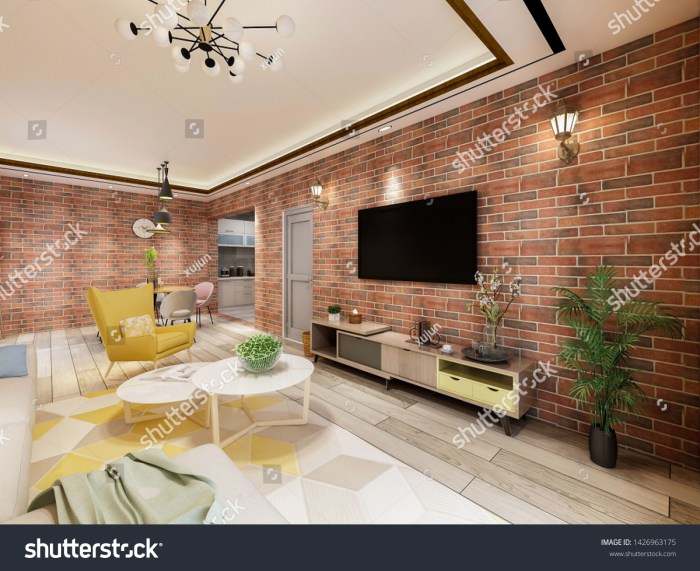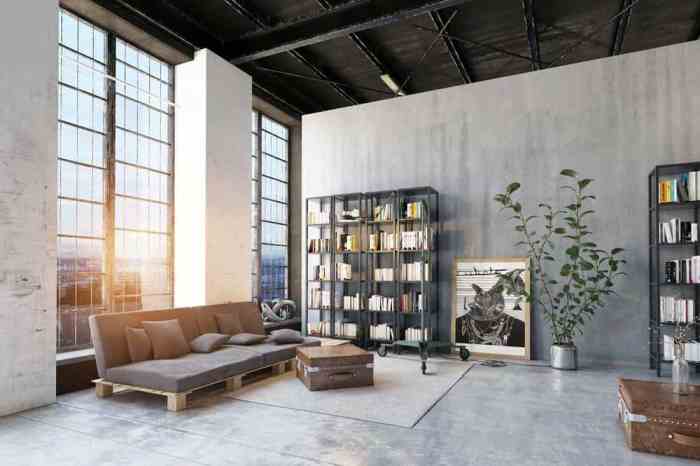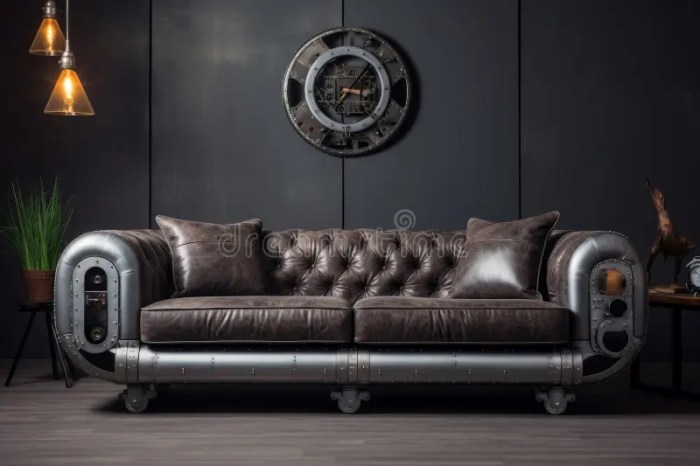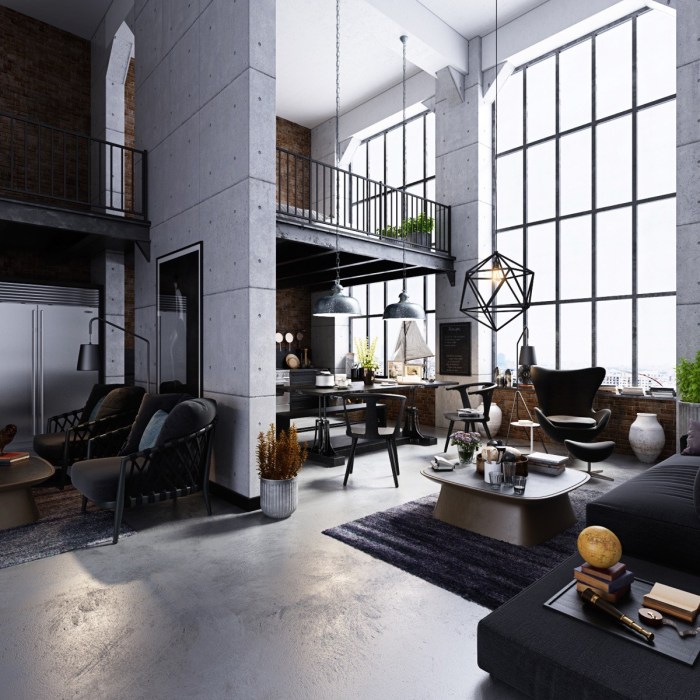The minimalist industrial living room: a captivating blend of streamlined functionality and raw, urban aesthetics. This design philosophy, a fascinating synthesis of opposing styles, achieves a unique balance. Minimalism, with its emphasis on clean lines, uncluttered spaces, and a focus on essential elements, meets the industrial aesthetic’s celebration of exposed materials, functional furniture, and a sense of history. The result is a space that is both visually striking and remarkably practical, a testament to the power of thoughtful design.
This exploration delves into the core principles of each style, demonstrating how their careful integration creates a living room that is both stylish and comfortable. We will examine furniture selection, lighting strategies, material choices, and decorative elements, providing practical advice and illustrative examples to inspire your own minimalist industrial haven. The journey will uncover the science behind creating a space that is both aesthetically pleasing and functionally efficient, using principles of spatial arrangement, light manipulation, and material science to achieve a cohesive and inviting atmosphere.
Defining Minimalist Industrial Style
Minimalist industrial style represents a fascinating fusion of two seemingly disparate design philosophies. It leverages the clean lines and functional simplicity of minimalism while incorporating the raw, utilitarian aesthetic of industrial design. This blend creates living spaces that are both visually striking and remarkably practical.Minimalist design prioritizes functionality and simplicity. Its core principles revolve around reducing clutter, emphasizing clean lines, and using a limited color palette.
This approach fosters a sense of calm and spaciousness, even in smaller rooms. The focus is on essential pieces of furniture and décor, each carefully chosen for its purpose and aesthetic contribution. This intentional curation prevents visual overload, promoting a sense of tranquility and order.Industrial style, conversely, draws inspiration from the architecture and aesthetics of factories and warehouses.
Key characteristics include exposed brick or concrete walls, metal accents, and the use of reclaimed wood. The overall effect is a raw, unfinished look that celebrates the inherent beauty of materials in their natural state. This style often incorporates elements of functionality, reflecting the utilitarian origins of its inspiration. Think exposed pipes, metal shelving, and vintage industrial lighting.The combination of minimalist and industrial styles in a living room creates a unique and sophisticated space.
Minimalism tempers the potentially harsh aspects of industrial design, preventing it from feeling cold or sterile. The industrial elements, in turn, add texture and visual interest to the minimalist’s clean lines, preventing it from becoming overly simplistic or bland. The result is a balance between clean functionality and raw, textural beauty. For example, a minimalist sofa might be paired with a reclaimed wood coffee table and exposed brick wall, creating a harmonious blend of both styles.
Color Palettes in Minimalist Industrial Living Rooms
Common color palettes in minimalist industrial living rooms often utilize a neutral base with strategically placed accents. This approach enhances the raw aesthetic of industrial elements while maintaining the clean feel of minimalism. The palettes are typically characterized by their muted tones and restrained use of color.
| Palette Name | Primary Colors | Accent Colors | Example Application |
|---|---|---|---|
| Neutral Monochromatic | Various shades of gray, off-white, beige | Black, dark charcoal gray | Gray walls, off-white sofa, black metal shelving, beige rug. |
| Industrial Steel | Steel gray, charcoal gray, dark brown | Rust orange, deep teal | Charcoal gray walls, steel-colored furniture, deep teal throw pillows, a rust-colored area rug. |
| Concrete & Wood | Light gray, concrete-like tones | Warm browns of natural wood | Light gray walls, reclaimed wood coffee table, natural wood flooring. |
| Warm Industrial | Warm grays, taupe | Warm metallics (brass, copper) | Taupe walls, brass light fixtures, copper accents on furniture, gray sofa. |
Furniture Selection and Placement
The successful implementation of a minimalist industrial living room hinges on a carefully curated selection and strategic placement of furniture. The overall aesthetic relies on a balance between functionality, clean lines, and the juxtaposition of raw, industrial materials with sleek, minimalist forms. This requires a thoughtful approach to both the types of furniture chosen and their arrangement within the space.The key is to avoid clutter while maintaining comfort and functionality.
Overcrowding, even with stylish pieces, directly contradicts the minimalist ethos. Conversely, sparsely furnished spaces can feel cold and uninviting. The goal is to strike a harmonious balance.
Suitable Furniture Materials
The minimalist industrial style thrives on a palette of materials reflecting its namesake. Metal, particularly steel and iron, forms a cornerstone of this aesthetic. Its raw, unfinished texture contributes to the industrial feel, while its inherent strength and durability align with minimalist principles of longevity and practicality. Wood, often reclaimed or with a distressed finish, provides a contrasting warmth and texture, softening the starkness of the metal.
Leather, in its rugged simplicity, adds a touch of luxury and tactile appeal, often seen in seating or accent pieces. Concrete, while less common for furniture itself, can be incorporated through coffee tables or side tables, further reinforcing the industrial aesthetic.
Effective Furniture Arrangement Strategies
Spatial optimization is paramount in a minimalist design. Furniture arrangement should maximize flow and functionality while maintaining a sense of openness. Creating distinct zones for different activities – seating, dining (if applicable), and potentially a workspace – helps to organize the space effectively. The use of open shelving instead of bulky cabinets keeps the room feeling airy and uncluttered.
Strategic placement of lighting, both ambient and task lighting, also plays a crucial role in highlighting the furniture and creating a welcoming ambiance. Furthermore, the incorporation of large windows and mirrors can visually expand the space and enhance the feeling of openness. Avoid placing furniture directly against walls, unless it serves a specific purpose (such as a built-in shelving unit), allowing for a sense of depth and movement within the room.
Sample Furniture Layout for a 15x15ft Minimalist Industrial Living Room
Consider a 15x15ft living room. Effective furniture placement is critical to optimize this space. The following layout suggests a balanced approach:
- A large, modular sofa (leather or fabric upholstery with a metal frame) positioned centrally, leaving ample space for movement. This acts as the focal point of the seating area.
- Two armchairs (metal frame with leather or fabric upholstery) flanking a low, rectangular coffee table (metal or reclaimed wood) placed in front of the sofa. This creates a comfortable conversation area.
- A media console (metal or reclaimed wood) positioned against one wall, housing a television and other entertainment components. This keeps electronics organized and visually contained.
- A large area rug (neutral tones) anchoring the seating area, defining the space and adding warmth underfoot.
- A floor lamp (metal, adjustable height) positioned next to the sofa, providing focused task lighting.
- Open shelving (metal or reclaimed wood) mounted on a wall, displaying decorative items and books. This adds visual interest without cluttering the floor space.
This layout prioritizes open space, functional zones, and a balanced blend of industrial and minimalist elements. The furniture pieces are carefully selected for their materiality, form, and contribution to the overall aesthetic. The arrangement facilitates both relaxation and social interaction within the defined zones.
Lighting and Decor

The interplay of light and carefully chosen decorative elements is crucial in achieving the desired atmosphere of a minimalist industrial living room. This space, characterized by its clean lines and functional aesthetic, benefits from a strategic lighting design that highlights architectural features while maintaining a sense of openness. Decorative choices should complement the industrial feel, adding warmth and character without compromising the minimalist ethos.Lighting options should be considered based on their ability to provide both ambient and task lighting.
The use of different light sources can create depth and visual interest, enhancing the overall aesthetic appeal. Furthermore, the selection of materials and fixtures directly impacts the overall ambiance, contributing to the intended industrial style.
Ambient and Task Lighting Solutions
Pendant lights, with their exposed wiring and industrial-style shades (often metal or glass), are a classic choice for minimalist industrial interiors. Their strategic placement above seating areas or dining tables provides focused ambient lighting. Track lighting systems offer flexibility, allowing for adjustable light direction to highlight specific areas or artwork. This system is particularly effective in larger living rooms, allowing for precise control over illumination.
Floor lamps, especially those with a metallic base and a simple, adjustable shade, add a touch of elegance and provide task lighting for reading or other activities. The interplay of these different lighting types creates a dynamic and functional lighting scheme.
Decorative Elements Enhancing Minimalist Industrial Style
Metallic accents, inherent in industrial design, are easily incorporated through lighting fixtures, furniture legs, or decorative objects. The raw, unfinished texture of exposed brick walls adds a layer of visual depth and texture, characteristic of industrial spaces. Strategic placement of plants introduces natural elements, softening the starkness of the industrial aesthetic while providing a visual contrast. These elements, when carefully considered, create a balance between the industrial aesthetic and a more inviting living space.
Five Decorative Items for a Minimalist Industrial Living Room
The following list details five decorative items, focusing on their material, shape, and ideal placement within a minimalist industrial living room:
- Item 1: A geometric metal sculpture. Material: Steel. Shape: Abstract, angular forms. Placement: On a mantelpiece or a side table. This piece adds a modern, industrial feel without cluttering the space.
- Item 2: A vintage industrial-style clock. Material: Metal, possibly with a distressed finish. Shape: Circular, with large, visible numerals. Placement: Hung on a wall, adding a functional yet stylish element.
- Item 3: A low, rectangular wooden coffee table. Material: Reclaimed wood, with a natural, slightly rough finish. Shape: Simple, rectangular. Placement: In the center of the living room, providing a functional and aesthetically pleasing centerpiece.
- Item 4: A large, potted succulent plant. Material: Ceramic pot, succulent plant. Shape: The plant will have a natural, organic shape. Placement: On the floor, next to a window or in a corner, adding a touch of life and softening the industrial feel.
- Item 5: A metal and glass lamp. Material: Metal base, glass shade. Shape: Simple, cylindrical or conical. Placement: On a side table or shelf, providing both ambient and task lighting.
Incorporating Natural Elements While Maintaining Minimalism
The key to successfully integrating natural elements like plants and wood is restraint. Avoid overcrowding the space. Choose a few carefully selected plants in simple, understated pots. Wood should be incorporated sparingly, perhaps through a single piece of furniture like a coffee table or a shelf. The natural elements should complement, not compete with, the industrial aesthetic.
The use of natural materials such as wood should ideally be limited to one or two key pieces of furniture to avoid disrupting the overall minimalist feel. A single, large potted plant can be more effective than several smaller ones, maintaining a sense of spaciousness.
Material and Texture

The minimalist industrial aesthetic relies heavily on a carefully curated selection of materials and textures to evoke a sense of raw, functional beauty. The interplay of contrasting textures and the inherent qualities of each material are crucial in achieving the desired atmosphere of refined simplicity and industrial heritage. Understanding the properties of these materials and their impact on the overall design is key to successfully implementing this style.The strategic use of materials and textures contributes significantly to the overall success of a minimalist industrial living room design.
The tactile experience adds another layer of depth and sophistication beyond the visual appeal. This section will delve into the specific characteristics of common materials used in this style, their textural contributions, and how their strategic combination enhances the space’s aesthetic appeal.
Material Properties and Textural Contributions
Metal, wood, concrete, and glass are the foundational materials of minimalist industrial design. Each possesses unique textural characteristics that contribute to the overall aesthetic. Metal, often steel or iron, offers a cool, smooth, or sometimes rough, depending on the finish, tactile experience. Its inherent strength and durability reflect the industrial heritage. Wood, typically reclaimed or with a distressed finish, introduces warmth and organic texture, counterbalancing the cold industrial elements.
Concrete’s porous surface provides a rugged, earthy texture, emphasizing the raw, unfinished feel. Finally, glass, with its smooth, transparent surface, introduces a modern contrast, adding a sense of lightness and airiness.
Texture Combinations for Visual Interest
The combination of these materials and their varied textures is key to creating visual interest within the minimalist framework. For example, the smooth, cool surface of a steel coffee table can be juxtaposed with the warm, rough texture of a reclaimed wood shelving unit. This contrast prevents the space from feeling monotonous. The smooth, polished concrete floor might be complemented by the coarse texture of a woven rug, adding a layer of comfort and visual intrigue.
The transparency of glass shelving units against the backdrop of exposed brick walls (a common feature in industrial spaces) creates a fascinating interplay of textures and depths. These contrasting textures add visual depth and prevent the room from feeling sterile or overly simplistic.
Material Application in Minimalist Industrial Living Rooms
| Material Type | Texture | Appropriate Use in Minimalist Industrial Living Room |
|---|---|---|
| Steel | Smooth, cool, potentially brushed or distressed for a rougher texture | Coffee tables, shelving units, lighting fixtures, accent pieces |
| Reclaimed Wood | Rough, warm, with visible grain and knots | Shelving, coffee table, accent wall, flooring (in some cases) |
| Concrete | Porous, rough, cool | Flooring, accent walls, countertops (in some cases) |
| Glass | Smooth, transparent, reflective | Shelving, tabletops, partitions, lighting fixtures |
Illustrative Examples

The following examples demonstrate the versatility of minimalist industrial design in living room spaces, showcasing how different color palettes, materials, and lighting schemes can create distinct yet equally compelling atmospheres. Each example leverages the core principles of the style: clean lines, functional furniture, and a blend of raw and refined elements.
Minimalist Industrial Living Room with Neutral Tones and Natural Light
This design prioritizes the interplay of natural light and a calming neutral palette. Imagine a spacious room with large, factory-style windows flooding the space with sunlight. The walls are painted a soft, warm gray, enhancing the natural light’s diffusion. The flooring is polished concrete, its cool gray tone contrasting subtly with the warmer wall color. Furniture is limited to essential pieces: a low-slung, light gray linen sofa, a reclaimed wood coffee table with a metal frame, and two simple, black metal armchairs.
Lighting is primarily natural, supplemented by strategically placed pendant lights with Edison bulbs, their warm glow complementing the overall ambiance. Minimalist decor includes a few carefully selected pieces: a large, abstract black and white print above the sofa, and a collection of succulents in simple ceramic pots. The overall effect is serene, airy, and inviting, highlighting the beauty of simplicity and natural materials.
Minimalist Industrial Living Room with Dark Color Palette and Bold Metallic Accents
This example embraces a more dramatic aesthetic. The walls are painted a deep charcoal gray, providing a rich backdrop for the metallic accents. The flooring is dark stained wood, adding warmth and texture. A large, black leather sofa anchors the space, its sleek lines reflecting the industrial aesthetic. A low, rectangular coffee table made of dark metal with a glass top adds a touch of modern sophistication.
Two black metal and leather armchairs flank the sofa. Lighting plays a crucial role: sleek, brushed steel floor lamps cast dramatic shadows, while recessed lighting provides functional illumination. Bold metallic accents are incorporated through carefully chosen decor: a large, brass-framed mirror reflects light, creating a sense of spaciousness, while a collection of copper and brass sculptures adds visual interest.
The overall feeling is sophisticated, moody, and undeniably stylish, showcasing the power of contrast and bold design choices.
Minimalist Industrial Living Room Featuring Exposed Brick Walls and Large Windows
This design celebrates the raw beauty of industrial architecture. The focal point is the exposed brick wall, its texture and color adding character and warmth. Large windows, possibly with metal frames, provide ample natural light, highlighting the brick’s intricate details. The flooring is polished concrete, its smooth surface contrasting with the rough texture of the brick. Furniture consists of a comfortable, neutral-colored sofa, perhaps in a durable linen fabric, and a simple, wooden coffee table with a metal base.
A few carefully selected industrial-style pendant lights, possibly with cage-like shades, provide ambient lighting. Decor is kept minimal, focusing on the inherent beauty of the space: a few carefully chosen plants in metal containers add a touch of life, while a vintage industrial-style clock adds a touch of character. The overall ambiance is both rustic and refined, highlighting the inherent charm of industrial spaces and the beauty of simplicity.
Concluding Remarks

Ultimately, the minimalist industrial living room transcends mere aesthetics; it’s a carefully orchestrated symphony of form and function. By understanding the principles of both minimalist and industrial design, and applying them thoughtfully, one can create a space that reflects personal style while maximizing comfort and efficiency. The journey through material selection, furniture placement, and lighting design culminates in a living room that is not just visually appealing but also a testament to the power of intentional design.
The raw beauty of exposed elements harmonizes with the clean lines of minimalist furniture, creating an environment that is both inviting and inspiring, a space where functionality and style coexist in perfect equilibrium.
Question Bank
What are some common pitfalls to avoid when designing a minimalist industrial living room?
Overdoing the industrial elements can lead to a cold, sterile feel. Conversely, insufficient industrial features might result in a bland, generic space. Striking the right balance is key. Another common mistake is neglecting the importance of texture; incorporating diverse textures prevents the space from feeling monotonous.
How can I incorporate color effectively in a minimalist industrial living room without compromising the style?
A neutral palette (grays, whites, blacks) forms the foundation. Introduce pops of color strategically through accessories like throw pillows, artwork, or plants. Bold metallic accents (copper, brass, or black metal) can add visual interest without overwhelming the space.
How much natural light is ideal for a minimalist industrial living room?
Maximizing natural light is crucial. Large windows are highly desirable. If natural light is limited, strategically placed lighting fixtures can mimic its effects, ensuring a bright and airy atmosphere. Consider the direction of the sun to optimize natural light exposure throughout the day.
What are some cost-effective ways to achieve a minimalist industrial look?
Repurposed industrial materials (like reclaimed wood or metal) can significantly reduce costs. Shopping for vintage or second-hand furniture can also be cost-effective. DIY projects, such as painting existing furniture or creating your own shelving units, can further reduce expenses.
Can a minimalist industrial style work in a small living room?
Absolutely. The key is to choose space-saving furniture and utilize vertical space effectively. Mirrors can also create the illusion of more space. A light color palette will further enhance the feeling of spaciousness.
